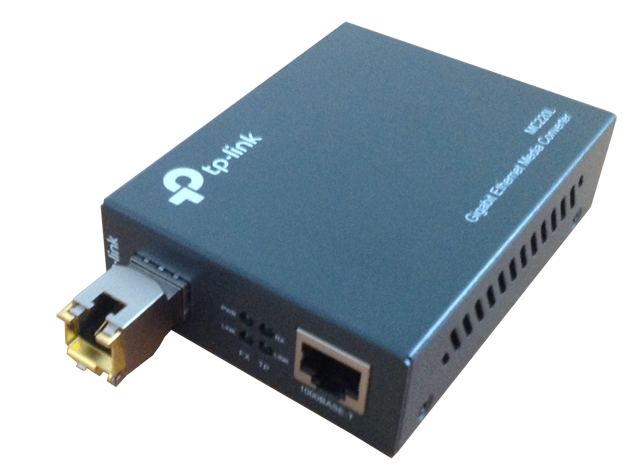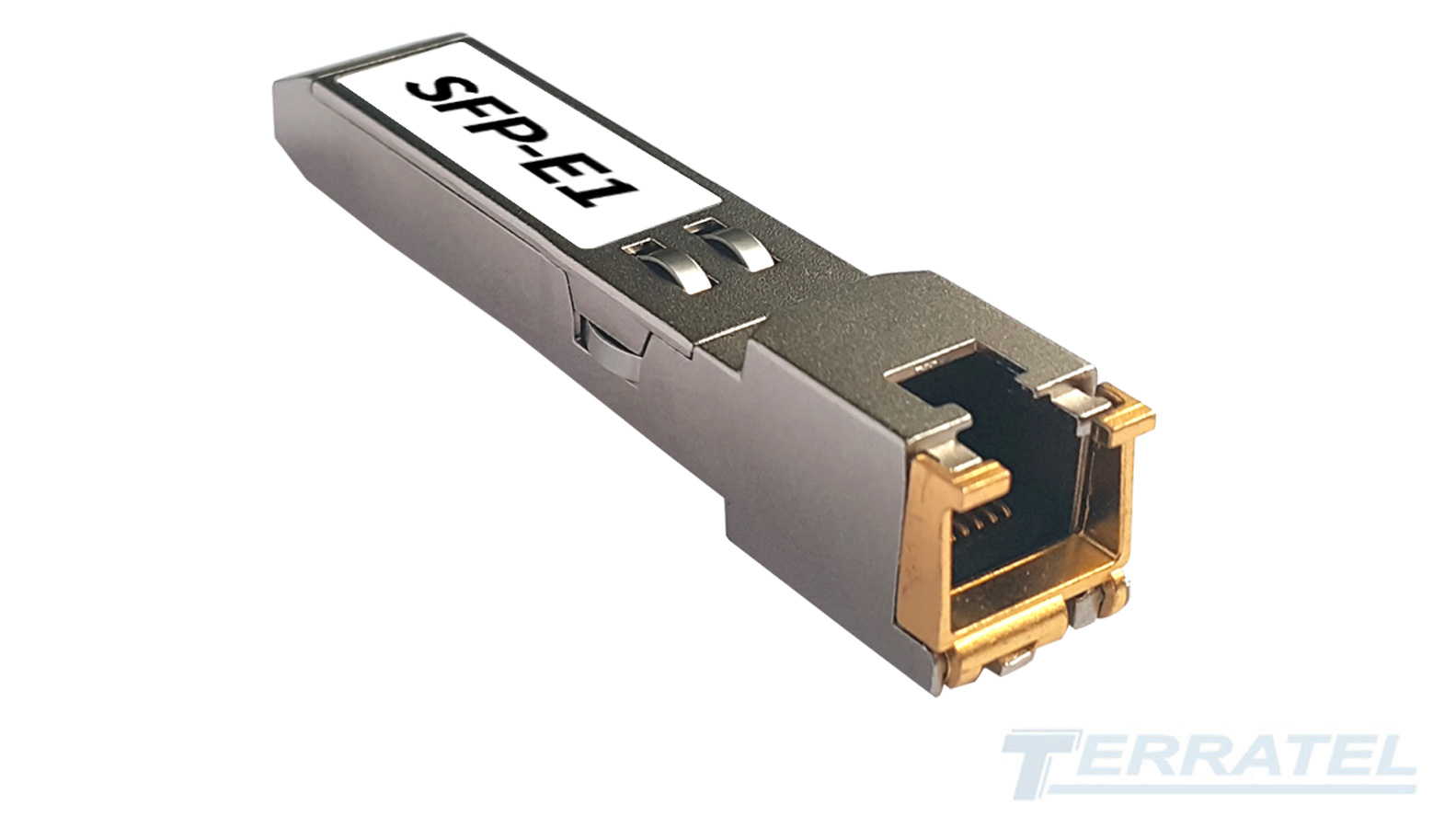Digital telephone module E1 in SFP form factor for integrating open software IP-PBX systems (Asterisk, FreeSWITCH, SipXecs, Yate) with PSTN or legacy PBX
Features
- Integration with software IP-PBX systems
- 1 E1 interface (G.703)
- Ethernet 1000 BASE-X SFP, 1 SIP trunk
- SIP and RTP (up 30 VoIP channel)
- ISDN PRI (DSS1, QSIG, Q.931), R2 MFC
- G.711, G.168, 32 msec tail length
- Fax over G.711, T.38 fax relay
- SNMP Monitoring
- Power consumption up to 1 W
Overview
The SFP-E1 module (or SFP VoIP Gateway) from Terratel is used to integrate and connect IP-PBX, IVR systems, VoIP gateways, and other specialized solutions from the Asterisk, FreeSWITCH, SipXecs or Yate projects to the PSTN public telephone network via the E1 interface ( or PBX).
SFP-E1 is a digital telephone module made in the SFP (Small Form-factor Pluggable) form factor, which hardware supports physical connections to the Ethernet network and the E1 interface.
To integrate with IP-PBX platforms Asterisk, FreeSWITCH, SipXecs, Yate, Kamailio, CallWeaver, the SFP-E1 digital telephone module supports the SIP protocol, which makes it effective when connecting a PSTN or legacy PBX.
Support for ISDN PRI signaling protocols (DSS1, QSIG, Q.931), R2 MFC for the E1 interface used in the TDM network, as well as the SIP protocol allows the device to be used for reconstruction legacy PBX.

Рис 1. Network diagram for integrating the SFP-E1 digital module and IP PBX systems
The SFP-E1 digital module exchanges data/voice over E1 channels and is an innovative device for building digital telephony systems based on IP-PBX with open source software.
Distinctive features
The design of the SFP-E1 module implements technology to support the E1 interface and signaling systems used in TDM networks. The SFP-E1 digital telephone module is designed to connect traditional TDM systems with voice over IP technologies into a single telecommunications network.
The SFP-E1 module is installed in the sfp-slot of network equipment, which allows it to be used anywhere where an Ethernet network is available, and not just at the location of the IP-PBX server.
This is the optimal solution that allows IP-PBX systems to connect to PSTN trunks or legacy PBXs using the E1 interface.
Key Features
- Up to 30 simultaneous calls per E1 port
- Support for E1 physical interface connection (ITU-T G.703)
- Support for TDM protocols: ISDN PRI (DSS1, QSIG, Q.931), R2 MFC, R1.5
- Support for IP network protocol – SIP
- Standard industrial RJ-45 port
- SFP form factor
Integration with open software IP-PBX systems
Connecting the SFP-E1 digital module to modern open IP-PBX software platforms, such as Asterisk, FreeSWITCH, SipXecs, Yate, Kamailio, CallWeaver, is carried out via the SIP protocol.
The SIP protocol (Session Initiation Protocol) is the most common in IP telephony.
The most popular telecommunication platforms that support the SIP protocol are Asterisk, FreeSWITCH, SipXecs, Yate.
The required configuration of the SFP-E1 module is configured via the device’s web interface.
PSTN and SIP trunks
The SFP-E1 telephone module from Terratel supports 30 connections to PSTN trunks or a PBX over one E1 digital stream.
The SFP-E1 digital module supports the following public telecommunications network protocols:
- ISDN PRI (DSS1, QSIG, Q.931)
- R2 MFC
- R1.5
The SFP-E1 module has a hardware echo cancellation function for all voice channels of the E1 stream (G.168, tail length 32 milliseconds), and also supports faxing (Fax over G.711, T.38 fax relay).
In the direction of an IP network or open telephone systems such as Asterisk, FreeSWITCH, SipXecs, Yate, the device supports the SIP protocol in one SIP trunk.
Configuration via Web interface
To configure the parameters of the E1 interface, Ethernet network and SIP protocol, the built-in Web server of the device is used.
The device’s web interface is simple and intuitive for user configuration.
A simplified list of steps required to integrate an SFP device into an open telecommunications platform like Asterisk:
- Install the device into a free SFP port of an Ethernet switch or media converter
- Connect the E1 interface
- Configure Asterisk (or other similar IP telephony system) to use the SIP protocol
- Configure the SFP-E1 module (E1, TDM signaling, device IP address, SIP server IP address)
- Save changes and reboot the device
Connecting via Gigabit Ethernet media converter
If during the installation of the SFP-E1 module there is no physical possibility of its inclusion in the local area network (LAN) through the SFP slot, you must use a budget media converter.

Pic 2. Sample of connecting SFP-E1 module via Ethernet media converter
Gigabit Ethernet media converter is a budget device that is designed to convert the signal and then connect the 1000BASE-SX fiber optic cable with a 1000 Base-T twisted pair cable.
Features of installation and dismantling
Installation and removal of the device is simple and does not require special skills.
SFP VoIP Converter is installed in a free SFP slot/port of the main network device (switch, router, media converter) from the side of the SFP electrical connector.
Installation and removal of the SFP VoIP Converter module can be performed both with the main network device turned off and on (hot-swap).
Operating conditions and temperature requirements
The device must be operated 24/7, in conditions that prevent overheating of the device and exposure to moisture. Proper ventilation conditions must be provided to prevent overheating of the device.
The operating temperature range that allows the device to operate stably is from 0°C to 50°C.
In case multiple SFP VoIP Converter devices are installed close to each other or installed in passive cooling network routers (switches), the network administrator must provide additional cooling.
The airflow around the SFP VoIP Converter devices must be increased or the overall ambient temperature must be reduced to the recommended operating temperature range.
To ensure proper operation, avoid exposure to high or low temperatures, as well as extreme conditions such as high humidity, large temperature fluctuations, or direct sunlight.
It is important to ensure good cooling of the device, especially in areas with high heat generation. Compliance with these requirements ensures stable operation of the SFP VoIP Converter device and its longevity.
Technical Specifications
| Network interfaces | |
|---|---|
| TDM – 1 E1 interface (G.703) |
|
| IP – Ethernet 1000 BASE-X SFP, 1 SIP trunk | |
| SIP and RTP (up 30 VoIP channel) |
| Signaling protocols | |
|---|---|
| IP – SIP, RTP, TCP, UDP | |
| PSTN – ISDN PRI (DSS1, QSIG, Q.931), R2 MFC, R1.5 |
| Feature support | |
|---|---|
| Voice codec – G.711 | |
| Echo Cancellation – G.168, 32 msec tail length | |
| Fax – fax over G.711, T.38 fax relay |
| Control & Management | |
|---|---|
| Embedded Web Server | |
| SNMP Monitoring |
| Power | |
|---|---|
| From the main device (DC 3.3V) | |
| Power consumption up to 1 W |
| Dimensions | |
|---|---|
| SFP form factor (14х14х67 mm) | |
| Weight – 0,025 kg |
| Operating environment | |
|---|---|
| Operating temperature: 0°С to +50°С | |
| Humidity: up to 80% at +25°С |
